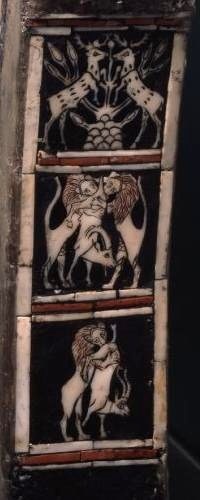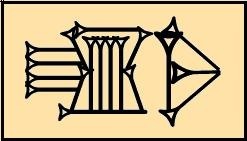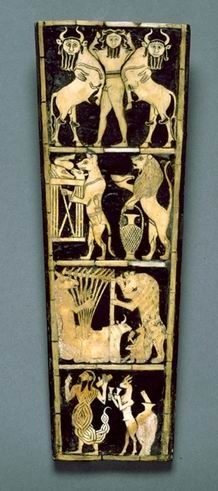Bask in the Beauty and Melody of the Ancient Mesopotamian Lyres of Ur
The Great Lyre: found in the King’s Grave. The head, face and horns are gold foil wrapped over a wooden form. The hair and beard are lapis lazuli, as are the eyes, inlaid into shell. The front panel is shell inlaid in bitumen. This image has been photographically enhanced to improve the color quality and to give an idea of how the lyre looked when it was new.
Click on the image to see the original photo.
See another view of the lyre additionally enlarged.
3/4 view of the Great Lyre. Click on the pictures to enlarge them in a separate window.
Leonard Woolley holding one of several lyres discovered in the Royal Tombs of Ur.
Two lyres and a harp, in situ, as they were found in the “Great Death Pit”. The lyre on the left is the Silver Lyre. In the middle is the Royal Harp, and on the right is the Golden Lyre, all of which are pictured below. The wood of the lyres had long ago decayed, but the forms of the lyres had been preserved by the silver sheeting and the shell inlays.
In the lower righthand corner is the remains of a female musician that has been reduced to a pile of jewelry, of which the ear pendants are the most prominent.

Three quarter view of the Golden Lyre.

A man plays a bull-headed lyre at the banquet of a king. The lyre is supported by a strap across his shoulder. The “woman” is a singer. There’s been some debate as to whether or not she is actually a woman because she appears topless, though it seems that a topless woman would not be entirely out of place at an all-male victory celebration. There is, however, the possibility that “she” is a male priest. Some Sumerian priests were known to wear wigs. Detail from the Standard of Ur. See another high-resolution photograph of the image. A similar figure occurs on a Sumerian plaque from Mari that depicts the ceremonial sacrifice of a ram. This person (second from the right) has sideburns, which seems to indicate that it’s a man.

This was the original attempt to restore the Great Lyre that shown at the top of the page.
Several lyres were found in the Royal Tombs of Ur, along with the bodies of the women
who played them. Woolley reports that one woman lay with her arm draped across her lyre,
with the bones of her hand where the strings had been, as if playing it.

Silver Lyre:. This is one of the two silver lyres found in “The Great Pit.” They were both made of wood, covered in sheet silver attached with small silver nails. The eleven silver tubes were tuning pegs. Height 106 cm. Length 97 cm. (approx. 42 x 38 inches).

Three-quarter view of the Silver Lyre.

Detail of the bull’s head on the Silver Lyre: The plaque on front of the sounding box is made of shell. The head has inlaid eyes of shell and lapis lazuli. The edges of the lyre are also trimmed with narrow borders of shell and lapis lazuli. Since the figure on the front of the lyre isn’t bearded, it may actually be a “cow” rather than a “bull,” though lyres of this type are generally called “bull-headed lyres.”

Lyre inlay on the Silver Lyre seen above. The top register shows two rams feeding on the high branches of a tree. This image occurs on many Sumerian artifacts and it seemed to have a symbolic meaning for the Sumerians that is not fully understood today. The lower registers show scenes of graphic violence in the natural world. This is a common motif in Sumerian art and it can also be found on many cylinder seals.
 Zamin (za3-mi2): This is the Sumerian sign for lyre. It also means “to praise.”
Zamin (za3-mi2): This is the Sumerian sign for lyre. It also means “to praise.”

The Queen’s Lyre: found in the tomb of Queen Pu-abi. The front panel, made of lapis lazuli, shell and red limestone, was attached with bitumen (bitumen is “tar” or “pitch”; the Sumerians used it as a kind of glue). The mask of the bull is gold. While the horns are modern, the beard, hair and eyes are original and made of lapis lazuli. The shape of the lyre is meant to resemble a bull’s body. Click here to see an enlargement of the other side. Height: 112 centimeters (44 inches).

Side view of the Queen’s Lyre: See a high-resolution photograph of it. In the background is a mosiac column found by Woolley at the temple of Ninhursag. See the details of the column.

Detail of the inlay panel of the lyre seen at the top of the page. According to the Penn Museum, “The front panel of the lyre tells the story of the funeral ritual itself. At the top, the nude hero grapples with two rampant human-headed bulls, representing royal control over nature. Beneath are three scenes that show the ritual with otherworldly actors. A hyena carries butchered meat on a table. Behind him is a lion, holding a jar and a pouring vessel identical to ones found in the graves. The third register depicts music-making: an equid plays a lyre while a bear supports it, nearby a small animal shakes a rattle. The lyre depicted is similar to the very lyre to which it was attached. On the bottom is the last stage of the ritual, where the deceased meets the scorpion man, the guardian of the entrance to the underworld.”
See high-resolution photographs of the registers: top, second, third, fourth
See a different high-resolution photograph of the entire panel

Curiously, the hyena carrying butchered meat wears a dagger with a studded handle like the one seen in the Weapons section. The lion also carries a pouring bowl like those seen in the Vessels section.

Boat Lyre, with a standing stag figurine. It is called a “boat lyre” because of its shape.
 Detail of a Sumerian woman playing a harp. This bas-relief is from a later period.
Detail of a Sumerian woman playing a harp. This bas-relief is from a later period.

Royal “Harp”: found in the Tombs of Ur. A harp is different from a lyre in tone and structure. It’s believed that the idea for a harp came from the sound that a bowstring makes when the string is plucked.
The above picture shows Woolley’s original reconstruction of the harp. He later realized that it was actually a harp and a lyre that had been compressed together by the weight of the soil. Below is a modern reconstruction of the harp with the box structure removed.

Modern reconstruction of the Royal Harp.
One of Queen Pu-abi’s cylinder seals shows a woman playing a harp, accompanied by two other women who play cymbals and perhaps sing. It would seem likely that the woman playing the harp is one of the attendants who folllowed Pu-abi into the afterlife.

Golden Lyre found in the Royal Tombs.

Golden Lyre: This is a modern replica of the lyre shown above. It was recreated by Andy Lowings (see his website, lyre-of-ur).

The original lyre was destroyed during the looting of the Baghdad Museum. Notice also the broken bowls at the lower right. Many of the artifacts from the Royal Tombs of Ur, which had survived for more than 4,500 years, were destroyed in a single day.

Modern reproduction of the face on the Golden Lyre.
Related Post
A shocking documentary proves that mermaids do exist
SHOCKING Revelation: Thuya, Mother of Queen Tiye, Was the Grandmother of Akhenaten and Tutankhamun—What Ancient Egyptian Secrets Did She Leave Behind?
Breaking News: Astonishing Discoveries at Karahan Tepe Confirm an Extraterrestrial Civilization is Hiding on Earth, and NO ONE Knows!
Breaking News: Researchers FINALLY Discover U.S. Navy Flight 19 After 75 Years Lost in the Bermuda Triangle!
NASA’s Secret Investigation: Uncovering the Astonishing Mystery of the UFO Crash on the Mountain!
Explosive UFO Docs LEAKED: Startling Proof That Aliens Ruled Ancient Egypt!


